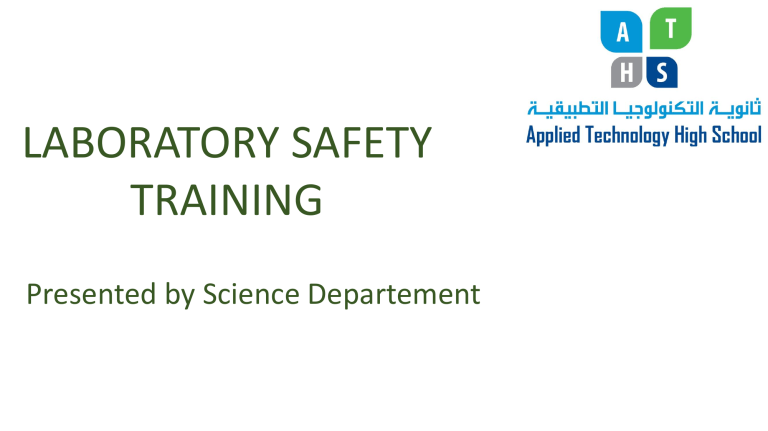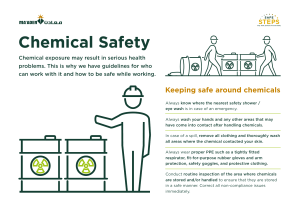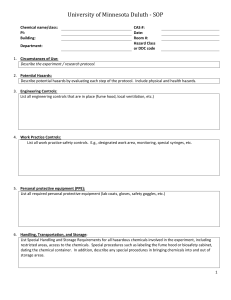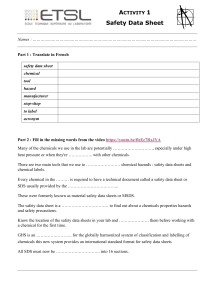
LABORATORY SAFETY TRAINING Presented by Science Departement Elements of the Safety Program The goal of the Laboratory Safety Program is to minimize the risk of injury or illness to laboratory workers by ensuring that they have the training, information, support and equipment needed to work safely in the laboratory. Laboratory Safety Manual INTRODUCTION Safety Policy II Roles and Responsibilities Faculty / Lab Managers All Employees and Students III EVACUATIONS PROCEDURES Fire Electrical Outage Critical Operations IV HEALTH HAZARDS OF CHEMICALS Toxic Effects of Chemical Exposure Routes of Entry V CONTROLLING CHEMICAL EXPOSURE Engineering Controls Administrative Controls Safe Work Practices Personal Protective Equipment (PPE) VI SAFE WORK PRACTICES Before you Begin Chemical Storage Segregation of Chemicals Personal Behavior Transporting Chemicals Working with Scaled-Up Reactions Unattended Experiments Working Alone VII Personal Protective Equipment (PPE) Eye Protection Safety Glasses Chemical Splash Goggles Face Shields Contact Lenses Gloves Respiratory Protection Protective Clothing Footwear VIII CHEMICAL SPILLS Spill Response and Clean-up Procedures IX WASTE DISPOSAL Chemical Hygiene Plan To provide every aspect for prudent work practices and procedures for the procurement, storage, handling and disposal of chemicals in the laboratory, in order to protect all personnel from the potential health hazards of the chemicals they may encounter in the laboratory. Engineered Controls The primary method of controlling chemical exposure! Fume Hoods When to use • When working with extremely volatile chemicals • High probability of chemical vapors Fume Hood Work Practices • • • • • • • • • • • • Know the toxic properties of the chemicals with which you work. (SDS) Be able to identify signs and symptoms of overexposure. (SDS) Keep all chemicals and equipment six inches from the sash Keep the sash completely lowered anytime "hands-on" experiments are not in progress or whenever the hood is on and unattended. Never utilize the hood unless there is some indication that the hood is operating. The hood is not a substitute for personal protective equipment. Wear gloves, safety glasses, etc., as appropriate. Visually inspect the baffles to be sure the slots are open and unobstructed. Do not block baffles. If large equipment is in the hood, put it on blocks to raise it approximately two inches so that air may pass beneath it. Do not use the hood as a storage cabinet. Keep the sash clean and clear. Clean all chemical residues from the hood chamber after each use. All electrical devices should be connected outside the hood to avoid sparks which may ignite a flammable or explosive chemical. Administrative Controls Changes in the method or process to reduce exposure. These include: • Substituting a less toxic chemical • Reducing the amount of the chemical being used • Reducing the length of the exposure time • Using plastic equipment instead of glass All Laboratory personnel are encouraged to look for and suggest changes in procedures to reduce exposure! SAFE WORK PRACTICES Be Aware of Your Surroundings Know the potential hazards and appropriate safety precautions before beginning work. Ask and be able to answer the following questions: • What are the hazards? • What are the worst things that could happen? • What do I need to do to be prepared? • What work practices, facilities or personal protective equipment are needed to minimize the risk? National Fire Protection Association (NFPA) LABELS Globally Harmonized System (GHS) • Product Identifier • Pictogram(s) • Signal Word Danger or Warning • Hazard Statement(s) Standardized and assigned phrases that describe the hazard(s) as determined by hazard Classification. • Precautionary Statement(s) Supplements the hazard information by briefly providing measures to be taken to minimize or prevent adverse effects from physical, health or environmental hazards. First aid is included in precautionary information. Personal Protective Equipment (PPE) Eye Protection Gloves Consult the SDS Clothing When Chemical Exposure Occurs Seconds Count! Chemicals on Skin or Clothing • Immediately flush with water for no less than 15 minutes. • For larger spills, the safety shower should be used. • While rinsing, quickly remove all contaminated clothing or jewelry. Seconds count. Do not waste time because of modesty. • Use caution when removing pullover shirts or sweaters to prevent contamination of the eyes. • Check the Safety Data Sheet to determine if any delayed effects should be expected. • Discard contaminated clothing or launder them separately from other clothing. Leather garments or accessories cannot be decontaminated and should be discarded. • Do not use solvents to wash skin. They remove the natural protective oils from the skin and can cause irritation and inflammation. In some cases, washing with a solvent may facilitate absorption of a toxic chemical. • For flammable solids on skin, first brush off as much of the solid as possible, then proceed as described above. • Fill out an Incident Report! Chemicals in Eyes • Immediately flush eye(s) with water for at least fifteen minutes. The eyes must be forcibly held open to wash, and the eyeballs must be rotated so all surface area is rinsed. The use of an eye wash fountain is desirable so hands are free to hold the eyes open. If an eyewash is not available, pour water on the eye, rinsing from the nose outward to avoid contamination of the unaffected eye. • Remove contact lenses while rinsing. Do not lose time removing contact lenses before rinsing. Do not attempt to rinse and reinsert contact lenses. • Seek medical attention regardless of the severity or apparent lack of severity. Explain carefully what chemicals were involved. If easily accessible, bring an SDS. • Fill out an Incident Report! Chemical Inhalation • Close containers, open windows or otherwise increase ventilation, and move to fresh air. • If symptoms, such as headaches, nose or throat irritation, dizziness, or drowsiness persist, seek medical attention. Explain carefully what chemicals were involved. • Review the SDS to determine what health effects are expected, including delayed effects. Accidental Ingestion of Chemicals • Immediately contact the Poison Control Center at 800-222-1222 for instructions. • Do not induce vomiting unless directed to do so. Accidental Injection of Chemicals • Wash the area with soap and water and seek medical attention, if necessary. Last but Not least • Fill out an Incident Report! Spill Response and Clean-up Procedures The individual(s) who caused the spill is responsible for prompt and proper clean-up • Immediately alert area occupants and evacuate the area, if necessary. • Contaminated clothing must be removed immediately and the skin flushed with water for no less than fifteen minutes. • Don personal protective equipment, as appropriate to the hazards. (Will a respirator be necessary?) (Now is not the time to read the SDS!) • Protect floor drains or other means for environmental release. • Loose spill control materials should be distributed over the entire spill area, working from the outside, circling to the inside. • Do not pick up broken glass with hands • When spilled materials have been absorbed, use brush and scoop to place materials in an appropriate container. • Complete a hazardous waste sticker, identifying the material as Spill Debris involving XYZ Chemical, and affix onto the container. • Decontaminate the surface where the spill occurred using a mild detergent and water. • Notify the Chemical Hygiene Coordinator! Category Small Size Response Treatment Materials up to 300cc chemical treatment or absorption neutralization or absorption spill kit Medium 300 cc - 5 liters absorption absorption spill kit Large more than 5 liters call public safety outside help Waste Disposal



